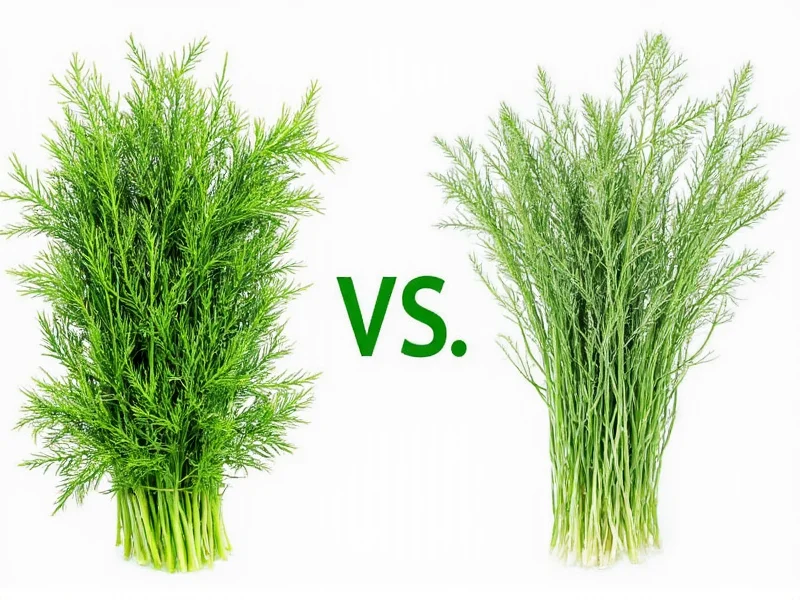Many home cooks encounter confusion when recipes call for “dill weed” versus “fresh dill,” mistakenly believing these are distinct ingredients. This misunderstanding stems from inconsistent labeling practices and regional terminology differences. Understanding the relationship between these terms is essential for accurate recipe execution and optimal flavor development in dishes ranging from pickles to seafood preparations.
Decoding the Terminology Confusion
The term “weed” in “dill weed” doesn’t indicate an undesirable plant but rather comes from an old English word meaning “herb” or “plant.” Grocery stores and spice manufacturers adopted “dill weed” to distinguish the leafy portion from dill seed. When you purchase “fresh dill” at the market, you’re getting the same product labeled as “dill weed” in dried herb containers.
Visual Identification Guide
Fresh dill features delicate, fern-like green leaves growing on thin stems, typically sold in bunches with roots attached. The leaves should appear vibrant green without yellowing or wilting. Dill weed as a dried product appears as crushed green leaves with a more muted color. Dill seed consists of small, oval, brownish-yellow seeds that grow in umbrella-shaped clusters on mature plants.
| Characteristic | Fresh Dill / Dill Weed | Dill Seed |
|---|---|---|
| Botanical Source | Leafy portion of dill plant | Mature seeds from flower heads |
| Flavor Profile | Grassy, slightly citrusy, mild anise notes | Stronger, earthier, more pungent, pronounced caraway-like flavor |
| Texture | Delicate, feathery leaves | Hard, oval seeds |
| Best Culinary Uses | Fish dishes, salads, dips, dressings, finishing garnish | Pickling, breads, hearty stews, spice blends |
Flavor Comparison and Culinary Applications
Fresh dill’s delicate flavor makes it ideal for dishes where subtlety matters. Its volatile oils dissipate quickly when exposed to heat, so chefs typically add it at the end of cooking or use it raw. The characteristic bright, grassy notes with subtle lemon undertones complement fish, potatoes, cucumbers, and creamy sauces perfectly. Scandinavian gravlax, Greek tzatziki, and Russian borscht all rely on fresh dill’s distinctive flavor.
Dill seed’s more robust profile withstands prolonged cooking, making it valuable in pickling brines, bread recipes, and hearty bean dishes. The seed contains different flavor compounds that emerge when crushed or heated, creating a warmer, spicier note that fresh dill cannot replicate. When substituting between forms, remember that one teaspoon of dried dill weed equals approximately three teaspoons of fresh dill, while dill seed requires completely different measurement approaches due to its intensified flavor.
Storage Techniques for Maximum Freshness
Proper storage significantly extends fresh dill’s shelf life. Treat it like cut flowers: trim the stems, place in a glass with an inch of water, cover loosely with a plastic bag, and refrigerate. Change the water every two days. Alternatively, wrap the herb in a slightly damp paper towel and store in a perforated plastic bag. Avoid washing until ready to use, as excess moisture accelerates spoilage.
Dried dill weed maintains quality for 6-12 months when stored in an airtight container away from light and heat. Dill seed retains potency for 1-2 years under similar conditions. Freezing fresh dill in oil or water preserves its flavor for up to six months, though texture changes make it suitable only for cooked dishes.
Common Substitution Mistakes to Avoid
Many cooks mistakenly use dill seed when recipes specify fresh dill, resulting in overpowering flavors that dominate rather than complement. Remember that dill seed and fresh dill are not interchangeable in equal quantities—use only one-third teaspoon of seed to replace one tablespoon of fresh herb. Tarragon makes the closest fresh herb substitute, though it lacks dill’s citrus notes. For dried dill weed substitutions, dried tarragon or a mix of fennel fronds and parsley can work in a pinch.
Maximizing Flavor in Your Cooking
For optimal flavor extraction, add fresh dill during the final minutes of cooking or as a garnish. Chopping releases more essential oils than tearing, but both methods work depending on desired texture. When making dill-infused oils or vinegars, use slightly bruised sprigs rather than finely chopped leaves to prevent bitterness. In pickling applications, combine both fresh dill and dill seed for complex flavor layers—the fresh herb provides top notes while the seed contributes depth.











 浙公网安备
33010002000092号
浙公网安备
33010002000092号 浙B2-20120091-4
浙B2-20120091-4